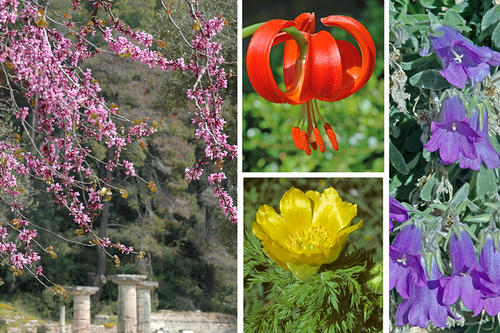Rediscovered Riches
Researchers from Freie Universität present a full checklist of all plant species in Greece
Nov 29, 2013
The Judas Tree (left) is widespread in the Mediterranean region as an ornamental plant. The smaller pictures show Lilium chalcedonicum (top middle), Adonis Cyllenea (bottom center), and Campanula Oreadum (right).
Image Credit: Arne Strid
Greece is home to vast botanical riches. Viewed according to the number of plant species by area, Greece even boasts the highest diversity of species anywhere in Europe. The recently published book Vascular Plants of Greece: An Annotated Checklist delivers impressive proof.
The research necessary to compile the checklist made it possible to show the presence of many plant species in Greece for the first time. From the Cretan date palm to Greek mullein, the book lists more than 5700 plant species and nearly 1900 subspecies. Alongside the Hellenic Botanical Society, the Botanic Garden and Botanical Museum Berlin-Dahlem (BGBM) of Freie Universität was also involved in the research project, and the two institutions published the book together.
“The reason for the checklist was a very specific need,” says Thomas Borsch, Director of the BGBM and a professor of systematic botany and plant geography. “Plain and simple, there was no complete list of all of the plant species in Greece. But every country and every region needs to have an overview of the plant species found there.” Ultimately, he says, neither plant conservation nor sustainable use of plant diversity is possible unless it is known which plants are present in the region in the first place. Without that knowledge, it is also impossible to compile a “Red List” of threatened or endangered species. With that in mind, scholars and researchers from the Hellenic Botanical Society and the Botanic Garden and Botanical Museum of Freie Universität Berlin embarked on the task of closing this gap in the available data. Eight botanists – five from Greece, two from Germany, and one from Denmark – spent three years examining the plant world in the Mediterranean country.
The eastern Mediterranean area, and especially Greece, has been a focus for research at the Botanic Garden and Botanical Museum for about a hundred years. This meant that the team was able to draw on a great store of experience and material. Borsch says, “We have several hundred thousand plant specimens from Greece and neighboring countries at our facility.” These collections often made it possible for the scholars to identify certain plant species in the first place, based on detailed comparisons.
Greece is home to such a vast diversity of species that it is not possible to identify all species with complete accuracy in the field. Plant expert Thomas Raus, who holds a doctorate, contributed his expertise in special measure in distinguishing among the species. Raus, an associated scientist at the BGBM, has been working with the flora of Greece for over 30 years. The international cooperation was also fruitful in another way: “We gave our Greek colleagues access to our botanical library, which is among the most comprehensive of its kind in the world,” Borsch says.
After all, he says, part of the aim of the project was to bring existing knowledge together with cutting-edge research, including the latest results of molecular biological testing. “Our Greek colleagues supported us in return, for example during field research on site. It was a very pleasant and balanced working relationship.” The fruits of all these efforts are tremendously important to botanists, vegetation specialists, ecologists, and nature conservation experts. The checklist will be used as a standard reference work for government agencies and NGOs working with the environment in Greece.
“With regard to the book, two things were important to us,” Borsch says. “We wanted it to meet rigorous scientific standards and also be affordable for anyone who was interested.” But the publication of the checklist does not mean the end of the cooperative relationship between the Greek and German botanists. The researchers aim to achieve a fundamental understanding of plant diversity in Greece. “The Aegean Islands represent a kind of natural laboratory, filled with many plants found nowhere else,” Borsch explains. “We want to trace how this diversity emerges,” he adds.
One reason is obvious: The Aegean Islands are home to a wide range of different environments, all of them isolated from each other. This has meant that different plant populations have thrived in isolation from one another over long periods, which in turn was conducive to the emergence of different genetic traits and led to the development of new species. “Every island in the Aegean Sea has its own plant species that are only found there,” says Borsch.
The scientists also aim to find out how, exactly, the species are distributed. The checklist offers an initial assessment in this regard, containing materials such as tables of the regions of the country where a species has been found. What is still missing now, Borsch says, is a comprehensive, modern work that documents the current state of knowledge about the Greek plant world in minute detail and offers instructions for identifying the plants by means of identification keys and illustrations. To date, only a few specialists have been able to identify the individual plants. “But to be able to list all the species in a conservation area, for example, we also have to give the relevant knowledge to non-specialists,” Borsch explains, adding that the new checklist is an important milestone in achieving that.
Further Information
Prof. Dr. Thomas Borsch, Director, Botanic Garden and Botanical Museum Berlin-Dahlem, Freie Universität Berlin, Tel.: +49 30 838-50133; Email: direktor@bgbm.org

